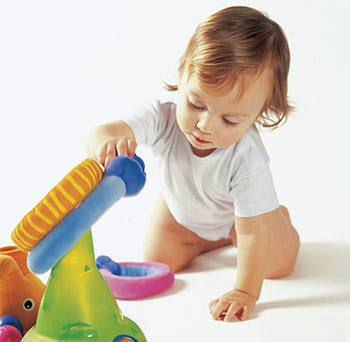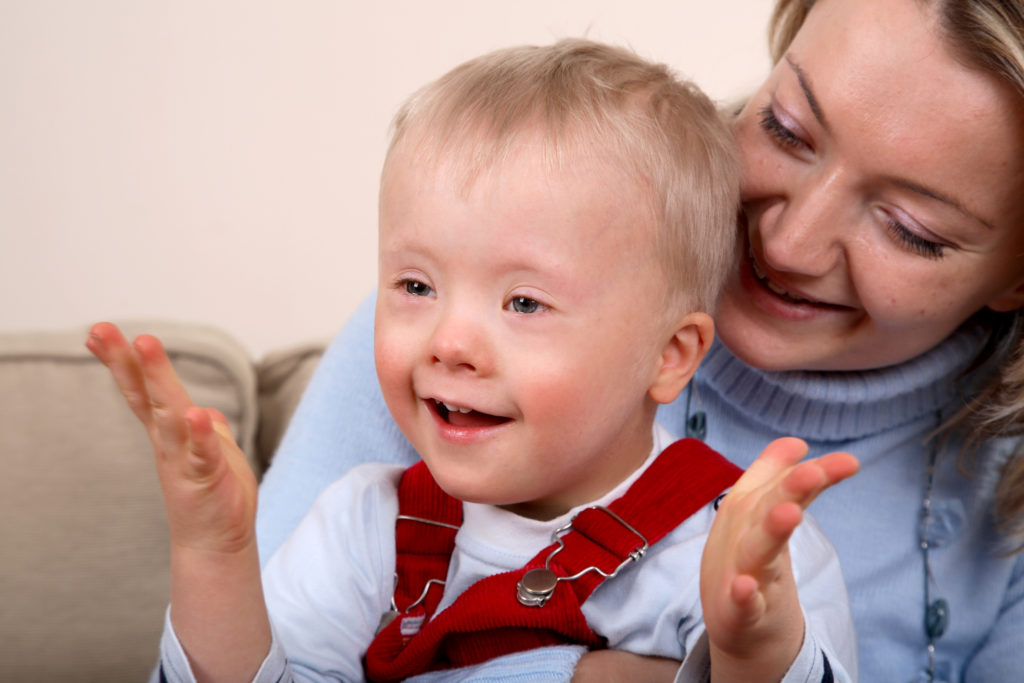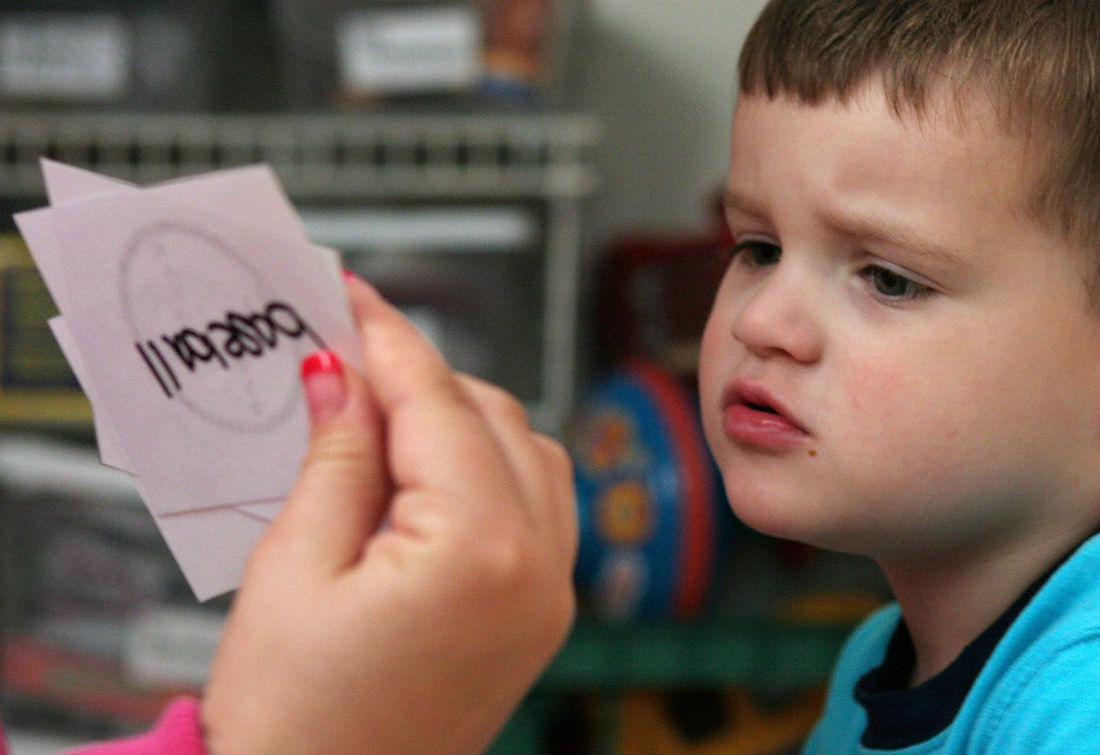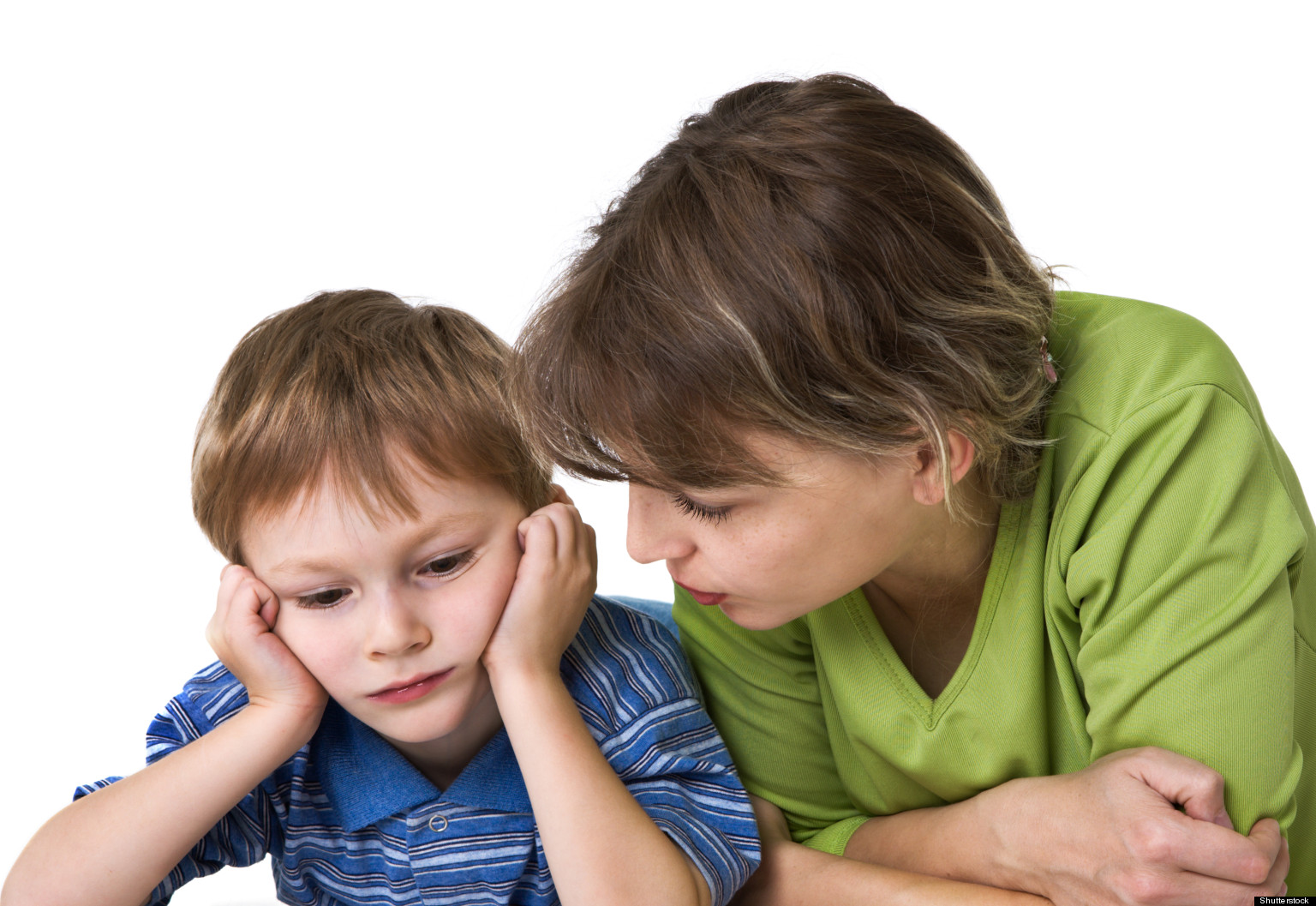Signs that the child is lagging behind in development. Causes of a child’s lag in development

The child is not like his peers - his overall development is lagging behind the norm, he does not cope with what is easily given to other children. About such children it is now customary to say "a special child." Of course, children with intellectual disabilities are a great challenge for parents. It is sad and painful to realize that the baby can be an outcast in society. However, quite often mental retardation is amenable to correction.
Is lagging or otherwise developing?
The development of children occurs in different ways. The norms according to which diagnostics of the mental development of children is carried out are rather relative and are averaged indicators. If a child develops at a different pace - this is not a reason to believe that the baby has gross violations of the development of the intellect. Cases when at an early age in a person there was a discrepancy between the norms of mental and intellectual development, and at an older age, he showed outstanding results in the field of knowledge - not uncommon. Even a delay in speech is not evidence of a child’s lag - many children do not speak at all until two years old, but at this time they have a passive vocabulary formation - after two such children begin to speak well and much at once. Therefore, if there is one or two deviations from age norms, do not panic. It is necessary to sound the alarm when there is a complex of signs of mental retardation.
Let us define mental retardation. First of all, the development of children with mental retardation comes against the background of fairly strong deviations of conditioned reflex activity of the brain. They have an imbalance of the processes of inhibition and arousal, the signal system of the brain also works with impairments. This greatly affects cognitive abilities - children lack attention or curiosity (craving for cognition), there is an underdevelopment of cognitive interests and will.
It is necessary to distinguish between mental retardation and mental retardation. Mental retardation implies more gross violations of the intellectual and psycho-emotional sphere. In severe cases, the correction of such violations is almost impossible - we are talking about severe cases of cretinism, oligophrenia. But I must say that in fact such cases are quite rare. Children with mental retardation differ in a number of features, and at the same time, the correction of their development is not only possible, but also quite successful: in some cases, children can catch up with their peers in their development.
Causes of mental retardation
There is a whole range of reasons that, all together or separately, can lead to a lag in development. Often, children with intellectual disabilities suffer from birth defects of hearing, vision, speech apparatus. With such defects, the initial intellectual abilities of the child could be within the normal range, but they did not develop from the first days of life due to decreased hearing and vision. Accordingly, there was a lag in mental development. The correction in this case is very successful.
Very often, the causes of mental retardation are severe pregnancy, during which a prolonged oxygen starvation of the fetus was observed; birth trauma, asphyxia at birth; some infectious and somatic diseases of a child at an early age, intoxication, genetic damage due to alcoholism or drug addiction of parents.
In a very large percentage of mild cases of mental retardation, education is to blame, or rather its complete absence. It is known that mental retardation occurs when parents do not engage with the child, do not talk to him; if for some reason a child at an early age was isolated from the mother. Here, too, the correction takes place in most cases successfully.
The development of mentally retarded children
Mentally retarded children need more time to perceive the material. Difficulties with the isolation of the main, with the knowledge of cause-and-effect relationships, the slowed-down rate of recognition of the known influence the child's learning ability, slowing down and complicating the learning process.
But this does not mean that the development of mentally retarded children is impossible or unnecessary. On the contrary, it is necessary to approach such children in a special way and to develop developmental activities very carefully, which should be more intensive. But the intensity here requires a different kind.
First of all, parents should have patience and faith in their child. The most important thing is never to compare a child with other children. Even for a healthy child with intellectual development within the normal range comparison is harmful - for special children it is catastrophically dangerous! As a result, the child becomes self-contained, begins to consider himself hopeless, falls into a neurosis or becomes aggressive.
In order to successfully correct the lag in intellectual development, it is necessary to conduct regular testing. The so-called diagnosis of the mental development of children is a set of special tests, standards, with which the child should normally cope upon reaching a certain age. Small deviations in one direction or another should not cause concern to the parents. If the child is clearly not up to the norm, corrective exercises in this area are necessary. Remember that mental development is uneven and there is a chance to develop the intellect and psycho-emotional sphere to the adult state. But overcoming the mental gap, even in a weak form, can take years and need to be prepared for this.
Of course, the development of mentally retarded children is a daily painstaking work that requires a lot of love, patience, and self-sacrifice. Parents need to constantly tell the child about the world, the relationship of things, give food for the mind, encourage people to use knowledge in practice. Scientists believe that a child with mental retardation should be surprised as much as possible - this awakens curiosity and a desire for knowledge. You should not even think that the child will not understand - you need to talk with him about everything, tell you why it is happening this way and not otherwise, show it.
Distraction of attention, inability and inability to concentrate it on one thing is one of the main reasons for mental retardation. Constantly training mindfulness, prompting it by all means within physiological terms (when the brain is being formed - up to 3-6 years), you can restore broken connections and lead to normality. Raising attention is so important that the rule here is that if a child is busy with something, classes are conducted with him, he has focused on the game - you cannot distract him even to food, sleep, and so on. For children with mental retardation, it is extremely important to protect the emerging concentration and attention.
In parallel with developmental activities, it is useful to take drugs that strengthen the nervous system and stimulate its development. From this point of view, decoction of nettle nettle, extract of Eleutherococcus, royal jelly, strawberries, blueberries, and B vitamins are useful.
In this article:
Loving and responsible parents are closely watching the growth and development of the children, along with him rejoicing in success and achievements, empathizing with failures. They analyze the behavior of the baby, record the emergence of new skills, relate them to the child's age and make preliminary conclusions regarding his level of development.
Despite the fact that each parent is proud of his child, he is obliged to take action when there are clear signs of a development lag — first, at least, to consult with doctors.
Of course, some parents are oppressed by the understanding that the baby may not be able to keep pace with their peers in development. Trying to ignore the obvious, they hope that the situation will eventually resolve itself and try to avoid society, thus not giving in to the child’s behavior of criticism or condemnation.
Such a way out of the situation is understandable, but not justified. Children whose parents will close their eyes to the problem, trying to escape from reality, will have less chance to find their place in life. The sooner the parents pay attention to some inconsistencies in the development of the baby to his age and contact the doctors, the more chances the crumbs will have for effective treatment.
Let's talk about in which areas development delays are most often fixed, what causes cause this problem and how to find the right way out of the situation.
Impaired mental function
Failures in the process of mental development of the child is not uncommon. The problem manifests itself in different ways. But, anyway, children with mental retardation have certain behavioral characteristics.
Children with mental retardation  developments are distinguished by special behavior uncharacteristic of their age. This is usually manifested:
developments are distinguished by special behavior uncharacteristic of their age. This is usually manifested:
- infantilism;
- increased fatigue;
- unwillingness to complete tasks to the end;
- quick change of activity.
The reasons that entail disruptions in the process of mental development of the child can be very different. For convenience, we divide them into biological and social.
Biological reasons include:

Social reasons include:
- parental hyper-care;
- pedagogical neglect;
- suppression of the child’s personality in the family;
- psychological trauma suffered in early childhood.
All the above reasons may affect the mental development of the child and cause his delay.
Diagnosis of mental retardation
Experienced specialists will be able to detect a lag in the mental development of a child in the first weeks of his life. Parents can understand that something went wrong in their younger preschool years, if they carefully observe how children behave at home, on the street, while communicating with other people.
It is possible to speak of mental retardation in case of improper development of basic reflexes:

Older children with mental retardation will have difficulty when it comes time to learn to pronounce and memorize new letters, they will hardly learn to read, and reading and writing will become an incomprehensible science for them.
Usually, children with mental retardation suffer from dysgraphia, are unable to work with numbers in the right order, are inattentive, do not know how to focus on one activity. In addition, these kids in preschool age have noticeable impaired speech skills.
Lag of children in motor development - a characteristic of the disease
Delayed motor development implies being late for  formation of posture and movements of children who do not have problems with the functioning of the nervous system. It is believed that the disease provoke:
formation of posture and movements of children who do not have problems with the functioning of the nervous system. It is believed that the disease provoke:
- preservation of the original primitive reflexes;
- increased joint mobility;
- premature birth with a serious weight loss;
- history of movement disorders.
To diagnose a delay in motor development in the first 6 months of a child’s life is very difficult, to say the least - almost impossible. A sick child, as well as a healthy one, is able to hold his head, uses his hands to grab toys and objects. Quite tolerable, children in most cases are able to crawl.
It is possible to speak about the presence of the motor developmental delay syndrome only in the second year of a child’s life, if he has not mastered the skills of standing and at least primitive walking before this time. Children suffering from this syndrome begin to walk, as a rule, not before the 20th month of life, and in some cases, the first steps appear only by the 25th month of life.
To determine  the presence of a problem before this time, experts use a number of time criteria:
the presence of a problem before this time, experts use a number of time criteria:
- inability to sit at the age of 10 months;
- crawling between the ages of 12 and 18 months;
- lack of walking skills at 14 months.
Children who begin to walk late are distinguished by immature coordination of movements. Visually, it looks like this: the baby puts his legs wide, without bending their knees. The first six months after mastering the skill of walking, the child will work out its basics and only in the second half of the year will he feel more confident in order to walk and even run without the support of adults.
Features of the syndrome ZDR
The hypermobility of the joints, which in this case plays the role of an inhibiting factor, has a great influence on motor development. Increased elasticity of the ligaments with increased joint mobility can also negatively affect the development of the overall motor skills of the child in the first 2 years.
Most serious  violation is excessive mobility in the ankle. It will be difficult for the child to keep the body in an upright position for at least two years.
violation is excessive mobility in the ankle. It will be difficult for the child to keep the body in an upright position for at least two years.
The good news is that, against the background of a delay in general motor development, fine motor skills may develop quite normally in children. Moreover, the baby will be equal to other children by the middle of the third year of life, when the delay disappears.
Does ZDR need to be treated?
There is no recognized treatment for ZD syndrome. In relation to the child who was made such a diagnosis, really  apply a number of activities to activate SLM, but all of them are of a general nature.
apply a number of activities to activate SLM, but all of them are of a general nature.
Most often, children are prescribed a massage for the limbs and back, offering a set of exercises for passive development of joints. If the problem is associated with impaired structure of the foot, which entails problems while walking, the child is recommended to wear special shoes with a stable back, arch support and hard soles to prevent the problem from worsening.
Signs of lag in relation to social and emotional development
The delay in socio-emotional development is most often the result of mental retardation. It is worth consulting with a doctor if children:

If you observe most of the signs in a child in the first 6 months of life, you should consult with a pediatrician and a neurologist.
Delays in the development of visual perception
As in the previous case, you should pay attention to a number of behavioral factors of the child, which may indicate that he has problems with the development of visual perception. These include:

All the above features indicate some problems in the formation of visual perception in children. You will need to consult not only a pediatrician, but also an ophthalmologist.
Lag in the development of auditory perception
It is necessary to show the child to the doctor if he has the following signs:

The pediatrician and the otolaryngologist will be able to help identify and solve the problem in such cases.
Lag in the cognitive development of the child
It is worth contacting a specialist for advice if children:

Help in such cases will be able to pediatrician, as well as a neurologist and psychologist after examining the child and diagnosis.
Backlog in the verbal development of speech: the main features
Parents should be wary and watch the baby if its behavior has the following features:

Timely diagnosis of the problem will help to select the appropriate treatment and prevent its aggravation. Doctors will be able to help in this: speech therapist, otolaryngologist and neurologist.
In conclusion, we note that it is necessary to observe the development of the child from the first days of his life, focusing on generally accepted norms. It is important to adequately assess the achievements of the child, paying attention to the appearance of failures in the process, in time consulting with the pediatrician. Parents should learn to observe the development process of the baby, not to panic every time he does not meet the schedule, and at the same time not to run obvious problems.
N.N. Zavadenko, Department of Neurology, Neurosurgery and Medical Genetics, Pediatric Faculty, Russian National Research Medical University named after N.I. Pirogov "Ministry of Health of the Russian Federation;
E.V. Kozlova, State Budgetary Health Institution “Morozovskaya Children's Clinical Hospital DZM”, Moscow
Key words: developmental dysphasia (alalia), diagnosis, complex correction, nootropic drugs, Pantogam
Keywords: dysphasia (alaliya), diagnosis, complex correction, nootropic medicines, Pantogam
The formation of speech - one of the main characteristics of the overall development of the child. Speech for the child is the most important means of communication with the outside world, communication and interaction with other people, as well as obtaining information for cognitive activity and development of thinking. Therefore, the development of speech is closely interrelated with the formation of all other intellectual abilities.
Signs of a lag in speech development are a pretext for prompt treatment of specialists, including a doctor (pediatrician, pediatric neurologist, ENT doctor, child psychiatrist), speech therapist, and psychologist. This is all the more important because it is in the first years of life that the deviations in the development of brain functions, including speech, are best corrected.
For the normal development of speech, a certain level of formation of the structures of the brain, articulatory apparatus, hearing integrity, as well as a full-fledged speech environment from the first days of a child’s life are necessary. The speech areas of the cerebral cortex, located in the dominant hemisphere (in right-handers - in the left, in left-handed - in the right) take part in speech implementation. Speech and sound analyzer (sensory center of speech, the center of Wernicke) is located in the temporal lobe of the dominant hemisphere and is responsible for the perception and differentiation of auditory signals, a complex process of understanding speech.
Speech motor analyzer (motor center of speech, the center of Broca) is located in the frontal lobe and provides a speech program, that is, the motor side of speech. The period from the first year of life to 5–6 years is decisive for the development of speech. Standards for the development of speech are given in Table 1.
Table 1.
Indicators of normal speech development in children from 1 year to 6 years
| Age | Speech skills |
|---|---|
| 2nd year | |
| 1 year | the appearance of one-word sentences |
| 1 year 3 months | word stock up to 30 |
| 1.5 years | vocabulary up to 40-50, easily repeats frequently heard words |
| 1.5–2 years | the appearance of phrases, two-word sentences |
| 1.5–2 years | first period of questions: “What is this?”, “Where?”, “Where?” |
| 2 years | vocabulary up to 200–300 |
| 3rd year | |
| 2 years | begins to use adjectives, pronouns and prepositions |
| 2 years | appearance of three-word sentences |
| 2.5 years | the appearance of verbose sentences |
| 2.5–3 years | difficulties of sound pronunciation (whistling, hissing, sonorous sounds) may remain |
| 3 years | vocabulary up to 800–1000 |
| 4th year | |
| 3 years | use of grammatical forms: changes of nouns in cases and numbers, verbs - by gender, tense, number and person |
| 3-4 years | second period of questions: “Why?”, “When?” |
| 3-4 years | phrases become longer, their meaning is complicated |
| 3-4 years | deficiencies in the pronunciation of a number of words (long and unfamiliar), the lack of clarity in the pronunciation of a number of sounds |
| 4 years | children express themselves in detailed sentences, including almost all parts of speech |
| 4 years | able to group items into classes: clothes, dishes, furniture, animals, etc. |
| 4 years | vocabulary - up to 2000 |
| up to 6 years | |
| 4–5 years old | statements take the form of a short story |
| 4–5 years old | almost all age-related abnormalities disappear |
| 5 years | able to make up a picture of several sentences from a picture, correctly answer questions about the storyline |
| 5 years | vocabulary - up to 2500 |
| 6 years | the number of simple common and complex sentences increases in speech; all the main parts of speech are used in phrases |
| 6 years | there are no defects in the pronunciation of sounds and words |
| 6 years | able to make a story (retelling) of 40–50 sentences with the development of the plot, reflecting in it the events of the past, present or future |
The reasons for the delay in speech development there may be pathology of the course of pregnancy and childbirth, the influence of genetic factors, dysfunction of the articulatory apparatus, damage to the organ of hearing, a general lag in the child's mental development, factors of social deprivation (insufficient communication and education). Difficulties in the development of speech are also characteristic of children with signs of physical development retardation, who have suffered from serious illness at an early age, are weakened, and are malnourished. Less often, the delay in the development of speech is associated with the presence of autism in the child or a general lag in mental development. In such cases, an in-depth neuropsychiatric examination is indicated.
The most severe disorders of speech development are alalia. They are based on an insufficient level of development of the speech centers of the cerebral cortex of the brain, which may be congenital or acquired in the early stages of ontogenesis, in the pre-speech period.
Complete or partial loss of speech, due to local lesions of the speech areas of the cerebral cortex, is called aphasia. Aphasia - the disintegration of already formed speech functions, therefore such a diagnosis is made only after 3-4 years. In aphasia, there is a complete or partial loss of the ability to speak or understand the addressed speech. In cases of early lesion of speech centers in children, speech develops, but with a pronounced lag. Domestic experts designate this condition as “alalia”, but the international term “dysphasia” or “developmental dysphasia” is more accurate. Similar to aphasias, motor and sensory alalia (dysphasia) are distinguished.
Prospects for mental development, learning success, school and social adaptation of children with developmental dysfunction depend on its early detection. As a reaction to speech impairment, many children with dysphasia develop neurotic features, isolation, negativity, self-doubt, internal tension, irritability, and resentment. With a small speech activity suffers from the general cognitive activity of the child. Speech in developmental dysphasia is not a complete means of communication, organization of behavior and individual development. Intellectual failure and limited knowledge that is observed in patients at different age periods, are thus secondary. It is this feature that distinguishes patients with dysphasia from children with a general mental retardation or mild mental retardation, which are characterized by a uniform incomplete formation of all higher mental functions and intellectual abilities. On the other hand, it is necessary to distinguish between dysphasia and tempo delayed speech development due to the lack of stimulation of speech development under the influence of adverse social factors (lack of communication and upbringing).
Motor alalia (dysphasia).
The cause of motor alalia is a dysfunction of the speech motor analyzer (motor center of speech). The child has difficulty organizing speech movements, coordinating them, and therefore speech development is delayed. Understanding of speech is not disturbed. Independent speech does not develop for a long time or remains at the level of individual sounds, words. Parents note silence, characterize children as understanding the addressed speech, but not wishing to speak. Instead of speech, children use facial expressions and gesticulations, especially in emotionally-colored situations.
The first words and phrases appear late. Parents note that, in addition to the lag in speech, in general, children develop normally. As the vocabulary increases, the difficulties of children in mastering the structure of the word become more noticeable. Speech slowed down, depleted, vocabulary is poor, limited to everyday subjects. There are many reservations (paraphasias), permutations, perseverations in speech. Growing up, children understand these mistakes, try to correct them.
Sensory alalia (dysphasia).
At the heart of the delay in the development of speech are disorders of her understanding. The child hears, but does not understand the addressed speech. This is due to impaired functions of the speech-analyzer (sensory center of speech). This leads to disorders in the analysis and synthesis of speech signals, as a result of which a link is not formed between the sound image of the word and the object or action designated by it. The child hears, but does not understand the addressed speech.
The degree of underdevelopment of a rean-analyzer can vary. In more severe cases, the child does not understand the speech of others at all, treats it as a noise, devoid of meaning, does not even respond to its own name. In other cases, he understands certain words, but loses them against the background of a detailed statement. In addressing him, the child catches not all the words and their shades, and therefore gives the wrong reaction. Often children face the speaker. In this case, the understanding of speech is improved by reinforcing the auditory impression from the visual analyzer - “reading from the face” occurs. Sometimes a child understands only one person (mother, teacher) and does not understand when someone else says the same thing.
When pronouncing words, there are numerous errors in stress, sound replacements, distortions, and with each new repetition the nature of distortions and replacements usually changes. New words and phrases the child masters slowly. The child’s sayings are inaccurate and difficult to understand. By his own speech, he is not critical.
There are incoherent repetitions of all words known to the child (logorea), repetitions of words, phrases (echolalia), while the words are not comprehended and remembered. In general, the speech of a child with sensory alalia can be characterized as an increased speech activity against the background of a disturbed understanding of the speech of others and insufficient control over their own speech.
In its pure form, sensory alalia is much less common than motor alalia, and, more often, sensory insufficiency accompanies motor alalia. In these cases, motor alalia with a sensory component is referred to.
The existence of mixed forms of alalia testifies to the functional continuity of speech-speech and speech-hearing analyzers. A thorough examination of the child with alalia allows one to clarify the nature of the disorders, establish the leading inferiority in the structure of speech disorders, and determine the optimal approaches to correct them.
The underdevelopment of speech in dysphasia (alalia) is quite deep and requires not only changes in the conditions of education, but also the help of specialists in the form of consultations or regular classes. Correction of this form of speech pathology takes a long time and requires great effort. Along with the conduct of speech therapy and psychological and pedagogical correction, children with alalia are recommended to prescribe repeated courses of therapy with nootropic drugs.
If special measures are not taken, the process of mastering speech will not just linger in time, but will become distorted.
The lack of help in early preschool years leads to the appearance of a number of consequences of speech underdevelopment. This is a violation of the process of communication and the resulting difficulties of adaptation in the children's team, immaturity in the emotional sphere and behavior, insufficient cognitive activity, difficulties in mastering the school program. Lack of speech or its underdevelopment necessarily have an effect at school age, when shortcomings in the development of oral speech create serious obstacles to the formation of writing, the development of reading and writing skills.
Treatment.
The main directions of correction for speech disorders in children are: speech therapy, psychological and pedagogical, psychotherapeutic assistance to the child and his family, as well as drug treatment (in the form of repeated courses of nootropic drugs). Of particular importance in organizing assistance to such children is the complexity of the impact and continuity of work with children of various specialists (doctors, speech therapists, psychologists, teachers). It is important that the joint efforts of specialists be aimed at the early detection and correction of violations of the formation of oral and written speech in children. Planning and carrying out remedial measures, including drug therapy, should be carried out according to individual plans for each child.
When conducting a complex correction in the development of the speech of children with alalia, positive dynamics can be traced, they consistently move from one level of speech development to another, higher, acquire new speech skills. It is well known that correctional assistance is effective, provided in a sensitive age for the formation of speech from 2.5 to 5 years, when the speech function is actively developing. But it should be noted that the earlier the trouble in the development of the child’s speech is noticed and the specialists start working with it, the better the results achieved will be, because the child’s brain’s spare capacity is highest in the first years of life.
Table 2.
Dynamics of indicators of speech development in children with dysphasia (according to parents)
The timely use of nootropic drugs contributes to the most complete correction of speech development disorders. We analyzed the effect of the nootropic drug Pantogam on speech and behavior indicators in children with developmental dysphasia. A comprehensive examination of 50 patients aged 3 to 5 years with developmental disorder of expressive speech (F 80.1 ICD-10) and a picture of general underdevelopment of speech 1-2 levels was carried out. All children were sent to a neurologist after a speech therapy examination, dynamic observation was carried out on an outpatient basis. From the studied group, children were excluded from whom the lag in speech development was due to hearing loss, mental retardation, autism, severe somatic pathology, malnutrition, as well as the influence of adverse social factors (insufficient communication and education).
In the course of the open controlled study, patients with developmental dysphasia were divided into two groups, which were observed over the course of 2 months: the 1st group —30 children (25 boys, 5 girls) who received Pantogam treatment; Group 2 (control) group - 20 children (15 boys, 5 girls) did not receive drug therapy. All children consulted a speech therapist and their parents were given advice on stimulating speech development.
Pantogam (homopantothenic acid) - calcium salt D (+) - pantoyl-gamma-aminobutyric acid. The chemical structure is close to natural compounds and is the highest homologue of D (+) - pantothenic acid (vitamin B5), in which beta-alanine is replaced by gamma-aminobutyric acid (GABA). Homopantothenic acid is a natural metabolite of GABA in the nervous tissue. Unlike GABA, penetrates the blood-brain barrier, is practically not metabolized by the body, and its pharmacological effects are due to the action of the whole molecule, and not individual fragments. Nootropic effects of homopanthenic acid are polymodal, associated with its stimulating effect on tissue metabolism in neurons, influence on neuro-mediator systems and contribute to the normalization of the functioning of the brain at the level of individual neurons and their synaptic connections.
Pantogam was administered in the form of a syrup of 100 mg / ml at a daily dose of 500–600 mg (30–35 mg / kg) for 2 months, in monotherapy, in 2 doses in the morning (after breakfast) and in the afternoon (after daytime sleep and afternoon snack) . To reduce the likelihood of side effects, the dose was gradually increased in the first 7–10 days of administration.
On the eve of the beginning of the course of treatment (day 0) and at the end of it (day 60), children with dysphasia underwent a neurological and psychological and speech therapy examination.
Indicators of the state of speech in children were analyzed by a special method. At the first survey, parents were asked to fill out forms that indicated: all the words the child pronounces at the moment, exactly how they are pronounced and what they mean (taking into account the numerous distortions when pronouncing words in children with dysphasia); all phrases pronounced by a child, how they sound and what they mean. Then parents were required to keep a detailed observation diary for 2 months, in which they should mark all new words and phrases that the child began to say, indicating the dates of the appearance of these words and phrases. In addition, during the first survey and after a two-month period, parents were asked to assess the general speech state of children with alalia on the following scales: speech perception (impressive speech), speech attention and colloquial (expressive) speech. Each of the indicators was evaluated on a 10-point system. Before and after treatment, parents were surveyed to identify manifestations of minimal brain dysfunction. Filling out the questionnaire provides not only the fixation of certain symptoms, but also a conditional assessment of the degree of their severity in points. Statistical analysis of the results was carried out using the non-parametric Wilcoxon test.
Table 2 shows the dynamics of speech development indicators in children with dysphasia according to parents' estimates using scales. Initially, expressive speech was lowest in all groups. In the group of patients who received the course of treatment with Pantogam, a significant improvement was achieved on all three scales: expressive, impressive speech and speech attention. In children of the control group, speech characteristics did not change significantly over the same period.
Table 3.
Dynamics of indicators of expressive speech in children with dysphasia
Table 3 presents the dynamics of objective indicators of expressive speech in children with dysphasia over a two-month observation period. In contrast to the control group, for children treated with Pantogam, there was a significant improvement in all analyzed parameters: there was a significant increase in the number of spoken words (active vocabulary), the average and maximum number of syllables in spoken words, the number of phrases in conversational speech, average and maximum number words in phrases. In the control group, only an increase in the volume of the active dictionary and the number of phrases was noted, but if during the treatment with Pantogam these indicators increased more than 3 times, then in the control group - only 1.5 times.
Table 4
Evaluation of treatment outcomes in children with developmental dysphasia according to the data of a parent questionnaire using a structured questionnaire
| Scale names | Scoring (M ± m) | |||
|---|---|---|---|---|
| Pantogam treatment | Control group | |||
| Day 0 | Day 60 | Day 0 | Day 60 | |
| 1. Cerebrastenic symptoms | 2.8 ± 0.2 | 2.0 ± 0.2 ** | 4.7 ± 0.5 | 4.6 ± 0.5 |
| 2. Psychosomatic disorders | 3.3 ± 0.2 | 2.4 ± 0.3 ** | 4.1 ± 0.4 | 3.4 ± 0.4 * |
| 3. Anxiety, fears and obsessions | 1.6 ± 0.4 | 1.4 ± 0.3 | 2.8 ± 0.6 | 2.2 ± 0.6 * |
| 4. motor awkwardness | 3.4 ± 0.3 | 3.0 ± 0.3 * | 5.9 ± 0.6 | 5.6 ± 0.6 |
| 5. Hyperactivity | 3.6 ± 0.4 | 2.6 ± 0.3 ** | 2.8 ± 0.5 | 2.8 ± 0.5 |
| 6. Violations of oral speech | 10.9 ± 0.2 | 8.7 ± 0.2 ** | 9.2 ± 0.4 | 8.6 ± 0.4 |
| 7. Lack of attention | 7.7 ± 0.4 | 6.5 ± 0.4 ** | 5.2 ± 0.7 | 5.2 ± 0.6 |
| 8. Emotional control | 5.5 ± 0.3 | 4.5 ± 0.3 ** | 6.7 ± 0.8 | 6.3 ± 0.7 |
| 9. Behavior problems | 3.6 ± 0.4 | 2.9 ± 0.3 ** | 3.6 ± 0.6 | 3.5 ± 0.6 |
| 10. Aggressiveness and opposition reactions | 1.1 ± 0.2 | 0.7 ± 0.1 * | 2.5 ± 0.7 | 2.5 ± 0.6 |
| Significant improvement: * p | ||||
The obtained results allow us to conclude that there is a significant positive effect of nootropic drugs on the state of speech of children with developmental dysphasia.
As shown by a survey of parents (table 4), during treatment with Pantogam in the group of children examined there was a significant decrease in the severity of cerebral symptoms (fatigue, emotional instability, tearfulness, poor appetite, headaches, difficulty falling asleep, restless superficial sleep), psychosomatic disorders (unreasonable pains in the stomach and other parts of the body, enuresis, parasomnias), motor awkwardness and the difficulties of fine motor skills. At the same time, the characteristics of attention improved, there was a regression of hyperactivity, emotional and volitional disorders (behaves inappropriately to age, shy, afraid to dislike others, overly sensitive, cannot stand up for himself, considers himself unhappy), problems of behavior, aggressiveness and opposition reaction. In comparison, a decrease in psychosomatic disorders and anxiety was observed in the control group.
The obtained results allow us to conclude that the pantogam nootropic drug has a significant positive effect on the state of speech in children with a general underdevelopment of speech of the 1-2th level due to developmental dysphasia. Meanwhile, it is necessary to take into account that the manifestations of dysphasia (alalia) are usually characterized by persistence and cannot be completely overcome in a short time. In cases where the results of the first course of drug therapy are insufficient, the issue of increasing the duration of treatment should be individually decided, and a second course of nootropics should be given after the break.
It is advisable to prescribe nootropic drugs in the form of monotherapy, while paying particular attention to the individual selection of the most optimal dosages and duration of treatment.
In conclusion, we emphasize once again the need for early detection, timely and comprehensive diagnosis and correction of developmental disorders of oral and written speech in children, joint efforts in solving these issues by doctors, speech therapists, psychologists, and parents. References are edited.
- Home decor for the new year
- Summary of literacy classes for children of the preparatory to school group "Sound and the letter Y"
- Voicing consonants: examples
- Algorithm for solving the ege on the Russian language
- · · Speech therapy commission in children
- Lexical theme: "Animals of hot countries"
- Recommendations for the development of coherent speech in preschool children

 Live journal
Live journal Facebook
Facebook Twitter
Twitter